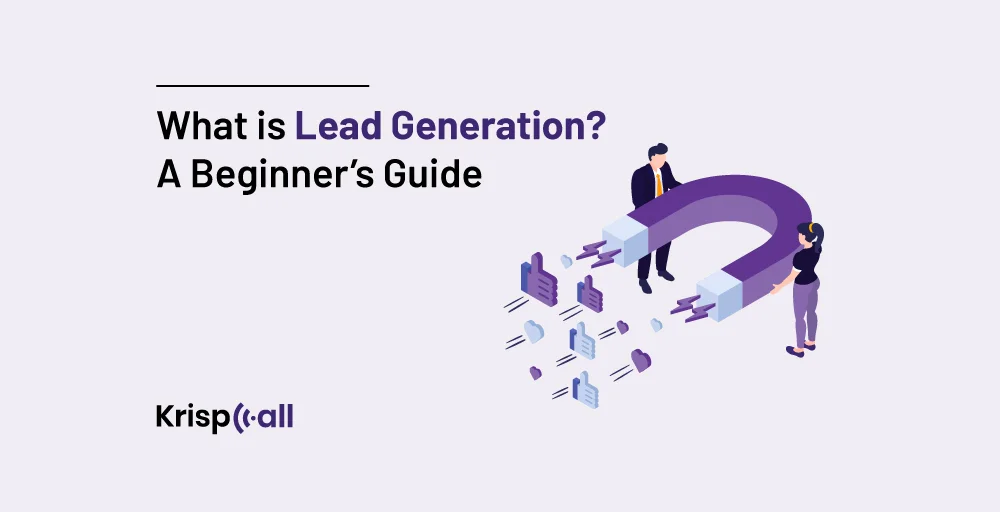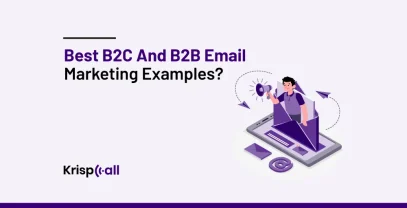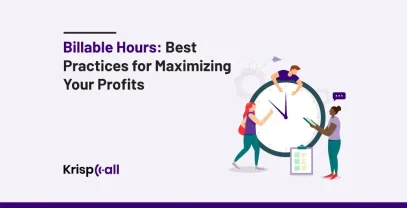Have you ever wondered how some businesses keep raising their sales? Or how they never seem to be out of customer? Then the simple answer to that question is lead generation.
Lead generation is the process of attracting potential customers to your business and converting them into paying customers. This simple yet impactful procedure is the reason behind many successful businesses throughout the world.
Now the temptation to implement it and get results immediately may arise but the question of how to do so may also be running through your mind. But don’t worry, this guide is here for the rescue. 🦸
This guide will equip you with the knowledge to understand lead generation, implement effective strategies, and watch your business flourish.
🔑 KEY HIGHLIGHTS
- The process of generating an audience’s interest in your product for sale is known as lead generation.
- There are different types of leads such as cold lead, hot lead, warm lead, marketing qualified lead, and product qualified lead.
- Inbound lead generation, Outbound lead generation, B2B lead generation, and Online lead generation are some types of lead generation.
- Identifying your audience, creating engaging content, and implementing CTA are some of the ways lead generation works.
- Generating leads process involves providing offers, request for referrals, and staying in contact with past referrals.
What is a Lead?
Leads refer to all those potential customers who’ve come across a company’s product or service and shown interest in them. Then, businesses or organizations typically identify or capture such potential customers through various methods such as social media, online surveys, landing pages, advertising, free courses, or direct inquiries.
After acquiring such valuable data and making them enter the sales funnel, it’s the sales and marketing team’s job to interact with them and convert them into paying customers. Leads are important for any business that is looking to expand its reach and increase revenue.
Types of Leads
Leads are part of the business that needs to be handled carefully. As the type of lead you have may differ, so classifying them into different categories makes it easy for you to approach them. Leads can be classified based on their qualification and the stage they’re currently in.
Here’s a breakdown of some common lead categories:
A. Leads Based on Level of Interest and Readiness to Make a Purchase
1. Cold Lead
Cold lead refers to the type of individual or organization that hasn’t shown any interest in your company yet but fits your potential customer’s needs and requirements perfectly. This type of lead fits the type of market you are operating in but still are unaware of or unengaged with your brand. So, you must be persistent, indicate their pain points, and always be there to nurture such types of leads.
2. Warm Lead
A warm lead refers to prospects who are aware of your company and have shown some interest in the products you offer. These types of leads generally follow your company on different platforms or even sign up for a newsletter. During this phase, despite the prospect showing interest in your company, they may still be in doubt about whether to make a purchase or not. So, it is your job to convert such desire into a purchase.
3. Hot Lead
Hot Lead is the type of lead in which the prospect has expressed a strong interest in what you have to offer. During this phase, they might request you for a demo, contact your sales team directly, or indicate that they are ready to buy. So, you must take immediate action and prioritize them more.
B. Leads by Qualification
1. Marketing Qualified Lead (MQL)
Marketing Qualified Leads are comparable to warm leads in one way or another. MQL refers to individuals or organizations who have come in contact with your marketing team’s efforts but are still not completely ready to make a purchase. Examples of such types of leads are prospects filling out online forms and submitting an email address for an offer.
2. Sales Qualified Lead (SQL)
A Sales Qualified Lead refers to a potential customer who has demonstrated a high level of interest in your product or service and is likely to make a purchase. An example of an SQL is a prospect who is downloading trial software or free ebooks, using software demos, or filling out online forms about the product query.
3. Product Qualified Lead (PQL)
Individuals or businesses who have used your brand’s product or service and have experienced the value it offers first-hand fall under the category of Product Qualified Leads. PQLs typically offer a product trial or limited version to their customers with the aim of converting them into long-term loyal customers.
4. Service Qualified Lead
Customers who are looking to buy more additional products or services from your brand fall under the category of Service Qualified Lead. This phase generally occurs when a customer informs your team that they want to make an additional purchase.
What is Lead Generation?
Lead generation refers to the process of generating your targeted audience’s interest in your product or service with the aim of converting that interest to a sale. Lead generation plays a crucial part in helping you scale your business even further.
Since its implementation, lead generation has become a crucial part of the sales funnel for many B2B companies or even startups. In the digital era, the process of generating leads has been simplified drastically. There are many unique ways a business can generate leads such as cold calling, email marketing, direct contact, and much more.
Depending upon the type of business you are operating the way you gain lead can differ. For example, if you are running a bakery offering a free downloadable recipe e-book in exchange for email addresses can be relevant. Whereas if you are running a software company hosting a webinar on the latest industry trends to attract potential customers can be ideal.
Types of Lead Generation
The type of leads needed can vary depending on the marketing approach being utilized. So, knowing more about the different types of lead generation offers you a better idea and ways to approach them.
Here are some of the types of lead generation:
1. Inbound Lead Generation
Inbound lead generation is the process of attracting any potential customer by creating and delivering valuable content and experiences. Unlike other methods, which actively reach out to prospects, inbound lead generation attracts people by offering helpful, relevant information that addresses their problems and ways to solve them.
Below are methods for inbound lead generation:
- Content marketing: It is one of the most effective ways of gaining more customers. Creating and sharing valuable content such as blogs, eBooks, whitepapers, and videos not only helps them to solve their problem but also helps businesses to gain more leads.
- SEO (Search Engine Optimization): Optimizing your website content to rank higher in search engines helps you to be the center of attention which is sure to attract more organic traffic.
- Email marketing: Sending targeted emails to nurture leads and collecting email addresses through sign-ups is still one of the best ways to generate leads.
- Webinars and online events: Hosting informative sessions to engage with potential leads helps to collect their contact information which is sure to offer value for your business.
- Social media marketing: Using social networks can be one of the quickest ways to engage with potential leads. Creating engaging posts and ads can pave the way for new customers.
2. Outbound Lead Generation
Outbound lead generation is the process of reaching out to potential customers directly, with the aim of generating interest in your product or service. Unlike inbound methods, which attract leads by offering valuable content, outbound lead generation mainly focuses on contacting prospects who may not have previously expressed interest.
Here are ways to generate outbound lead generation:
- Cold calling: Cold calling is effective in today’s world. It is the process of directly calling potential leads via phone to pitch your products, offers, or services.
- Direct mail: This refers to the method of sending physical mail, such as brochures or postcards, to potential leads to make them aware of your brand’s presence.
- Cold emailing: It is still one of the best methods to reach out to potential clients. This method is simply conducted by sending unsolicited emails to potential leads.
- Advertising: Launching paid ads on search engines, social media, or any other platforms is one of the ways to reach potential leads.
3. B2B (Business-to-Business) Lead Generation
B2B lead generation involves identifying suitable businesses for your product or service and cultivating them into potential customers.
B2B is different compared to B2C (business-to-consumer) lead generation as B2C only targets individual consumers, while B2B lead generation focuses on companies, organizations, or professionals as the target audience.
Here are some ways of generating B2B leads:
- LinkedIn marketing: LinkedIn is a platform that is packed with many businesses. So, utilizing it for networking, ads, and direct outreach is sure to prove useful for you.
- Industry events: Attending business events is one of the best ways to generate leads for your business.
4. Online Lead Generation
Utilizing the online world can make things way easier when it comes to generating leads. By leveraging online tactics and tools you can easily reach and engage with prospects.
With online lead generation, you get the advantage of reaching a wide range of audiences while providing measurable results and opportunities for continuous improvement.
Here are some examples of online lead generation:
- Landing pages: Creating dedicated pages that are optimized for capturing lead information.
- Lead magnets: Offering free resources (eBooks, templates, checklists) in exchange for contact details.
- Chatbots and live chat: Using automated or live chat services on websites to engage visitors and collect their information.
5. Offline Lead Generation
This method relies on traditional marketing and networking tactics to reach and engage with a customer base. Offline lead generation offers the advantage of building personal relationships and trust, as well as reaching audiences who may not be active online.
However, it usually requires more resources and time compared to online lead generation.
Here are some examples of offline lead generation:
- Networking events: Attending industry-specific events to meet potential leads.
- Workshops and seminars: Hosting educational sessions to attract and engage potential leads.
- Community involvement: Participating in local events and sponsorships to build brand awareness and generate leads.
6. Hybrid Lead Generation
This strategy is a combination of online and offline lead generation. By integrating online and offline channels, you can effectively engage with prospects across different touchpoints. This increases the chances of capturing high-quality leads.
How Does Lead Generation Work?
Lead generation works from appearing in prospects raiders to turning them into paying customers. Multiple strategic steps, methods, and careful work are conducted behind the scenes to generate high-quality leads.
So, let’s break down how strong lead generation is formed:
1. Identify your audience
Identifying the type of audience, you are aiming for is the first step in generating leads. So, always conduct research to understand what your targeted audience’s needs, preferences, and challenges are. Then build a proper list outlining preference, pain points, and even demographics. This offers you a better insight into who to reach out to first.
2. Create engaging content
Develop engaging and valuable content to attract potential customers and exchange their information in return for the content. Such content can be in the form of blog articles, guides, videos, or photos. This information gained during this phase serves as the ticket to generate more leads and even a chance to pitch them offers.
3. Utilize different platform
Utilize different marketing channels such as social media, email marketing, search engine optimization (SEO), and pay-per-click (PPC) advertising to announce yourself to the targeted customers. Since different channels are filled with different leads, maintaining an effective presence across each channel can prove to be useful.
4. Implement CTA
Include a Click to Action (CTA) button in every piece of created content, this will encourage visitors to take the next step within their customer journey, usually by filling out a form or contacting the business directly. CTAs serve as a connection for companies wanting to directly interact with visitors looking for information.
5. Capture leads
Capture any visitors by encouraging them to fill out the online forms. This type of form is utilized to gather information from leads who have interacted with your company’s website content. These forms commonly ask for contact details such as name, email address, phone number, and occasionally additional information like company size or industry.
6. Utilize lead scoring and segmentation
Lead scoring makes it easy for you to rank leads according to their level of interest and interaction. The greater the score, there is a high probability that a customer is ready to make a purchase. This makes it easy for you and your teams to customize their marketing strategies according to the leads.
7. Nurture leads
Once leads are secured it is not over. You must continue to nurture them more carefully to form a bond. You can utilize different methods to nurture leads such as email marketing, personalized content, or other methods which you prefer to lead them to make a purchase.
8. Increase conversions
Converting leads into paying customers is the sole goal of lead generation. So, utilize different means such as offering trials, discounts, or product recommendations to convert such leads to paying customers. By attracting qualified leads, nurturing relationships, and tailoring your approach, you can significantly improve your conversion rates and achieve your business goals.
9. Measure and optimize
Always track the effectiveness of lead generation activities by using the tools utilized to carry out the campaigns. Evaluate important indicators such as conversion rates, click-through rates, and return on investment (ROI). Utilize this information to enhance strategies for improved outcomes, and successful campaigns within a specific target audience.
Why Choose Lead Generation for Your Business?

No matter what type of company or organization you are operating, lead generation is a necessary procedure. Without lead generation, any business is sure to decline in the chart of sales.
Especially in today’s competitive business, just because you have a great product or service doesn’t mean you will have the most sales. You need to showcase your brand and product in front of the right people who are truly looking for what you have to offer. That’s why lead generation is important not only for sales but to save your overall time. It’s a one-way ticket to increase your business revenue and gain a steady flow of customers.
For example, you sell the best cake within your area, but your sales have still been the same since the beginning do you know the reason why it is happening? – it’s a lack of leads. This solo example indicates how much of important it is to generate leads for the business.
Lead Generation Process
There are different steps included in the lead generation process. Here is an example that overviews the lead generation process.
- A potential customer discovers you through one of the marketing channels you are active in such as social media, website, or blog.
- After that, the potential customer shows interest by clicking on a CTA button, such as an image, a “sign up” button, or a link to another landing page that offers a free resource in exchange for their data.
- Now the potential customer enters their data into a form, receiving their free resource and opting into future marketing efforts from your business.
- Once a potential customer rolls in, you would then nurture a sequence of valuable content to guide them toward a purchase.
How to Generate Leads?

Generating leads can be done in various ways. You don’t need to be bounded within simple steps. You can experiment with different methods and look out for the best for your business.
Below are some of the ways you can generate leads for your business:
1. Provide offers
Everybody loves free things or products that are discounted. Providing or creating such offers for your products helps you to gain valuable data for any prospects who visit your brand. So, always consider offering any visitors various offers such as free tools, free trials, or a certain percentage discount. This offers a temptation for your visitors to share their information.
2. Request for referrals
Happy customers are the fuel for more customers. By treating them right and offering the right products you can easily gain yourself a happy customer. This type of customer can increase word-of-mouth marketing which eventually helps you to generate more leads. Therefore always ask your buyer if there is anyone who might appreciate your product or service. This is time efficient and maybe one of the quickest ways to generate leads.
3. Regularly conduct customer care calls
Continuing to engage with your customers even after a successful sale is crucial. A customer who has a already purchased product from your brand and is happy with it, the chances of repeat purchase are high. They just need some fueling. So, follow-up calls can be that fuel to nurture customer relations and a great time to ask for referrals.
4. Stay in contact with past referrals
Staying connected with past referrals is one of the best ways to generate leads. You can stay in touch through thank you notes, informative emails, or social media engagement to keep your brand in their mind from time to time. This allows you to share updates, special offers, or valuable content that might compile with them.
By keeping the connection strong, you gain potential access to a network of warm leads you wouldn’t have reached otherwise. Furthermore, reconnecting can provide valuable insights into their experience, helping you improve your offerings and messaging to attract even better leads in the future.
5. Choose the Right Channels
Identifying the marketing channels where your target audience spends their time can be a huge plus point to generating leads. Such marketing channels may include social media platforms like LinkedIn, Twitter, or Facebook, industry publications, search engines, email marketing, or a combination of these channels. So, focusing your efforts on such channels helps you to reach the type of lead you are looking for resulting in more leads for your brand.
6. Showcase your expertise
Nowadays, most customers research the product they are looking to buy even before they get in direct contact with a company representative. So, building your presence within the internet world can be huge for your brand. Offering customized, interactive, and engaging content to meet their questions can eventually lead such customers to your brand even before they notice.
7. Build network
Networking is great for nurturing leads. Always look out for networking events that are both local and can offer value for your industry. This will help you to connect with fellow business owners and know the things that you are lacking.
So, you must not walk in with ROI in mind instead, look for a bigger picture. During this event, you may meet a complementary business that you can partner with to share leads, expanding your reach. Networking can even open up guest blogging opportunities for your company.
8. Be creative
Creativity also plays a major role in generating leads. To stay ahead in this competing market, you must find fun and creative ways to announce your brand to the public.
Always try to think of different ways to approach and interact with your potential customers. You can also organize a free seminar, discount, and many more. This is one way of interacting with your targeted audience while generating leads. Try different ideas, and eventually, you will crack the code to generate leads.
9. Don’t give up
Any successful company knows how much value a lead offers. Generating leads involves many steps, such as conducting customer care calls, asking for referrals, and nurturing leads. Developing your brand image as a trusted source on the internet and social media is also a lead generation strategy.
But strategies without consistency are nothing more than a bluff. Very few customers are going to be mad at the first contact, but it’s your job to be consistent and make them feel welcome. Understanding and practicing lead nurturing is part of grasping how to generate leads.
Why is Generating Leads Organically Better Than Buying Leads?
Well, every business is looking for ways to increase their sales quickly. This simple reason leads many businesses to pursue the way of buying leads. While buying leads seems easy and handy, in the end, it is not going to get your business further.
So, here is the breakdown of the reason why generating leads organically is better than buying leads:
1. Quality of the lead
Purchasing a lead from third-party companies doesn’t always mean you’re getting the right information. When someone finds you through SEO or social media, it indicates they are attracted to things you have to offer them. This leads them to take the initiative to learn more about your company or the problem you solve. This often results in higher-quality leads which are more likely to convert into sales.
On the other hand, purchased leads can be mixed signals. While some may be interested, others may not be a good fit for your product or service. The third-party companies might have gathered the data extensively without considering individual needs or demographics, leading to a decreased likelihood of conversion.
2. Costly
Buying leads can cost you a high amount as you have to purchase the data and information from third-party companies. In addition, it’s possible that you might end up reaching out to prospects who have no real interest in your product and service.
This eventually wastes your resources. Beyond the initial purchase price, there can be hidden costs associated with following up on unqualified leads.
So, generating leads organically helps you save money for better usage as well as helps you to know more about the prospects with whom you are to engage.
3. Create a negative brand image
Having a list of unknown leads isn’t always the right thing. Through this list, there will be many leads who are unfamiliar with your company and have been approached because they left their information elsewhere.
This may lead to some kind of confusion between the leads and your brand which could create a negative image that may even affect your brand’s future.
4. Sustainability
Organic lead generation is a continuous process that helps your brand to succeed in the long run. As your content climbs in rankings and your brand recognition expands, you will naturally draw in a consistent flow of leads.
On the other hand, purchased leads are nothing but one-shot. After you have gone through all of the list, you must make another purchase, whereas organic generation establishes a mechanism for an uninterrupted lead stream.
5. Spam
With organic lead generation, you can control the content you create and the target audience you attract. You can even customize your approach to attract leads that are a perfect fit for your ideal customer profile. Whereas the quality and targeting of purchased leads can vary greatly depending on the source. You may have less control over the demographics and interests of the leads you receive.
Lead Generation Strategies

No matter what field you are having, a proper strategy laid out can boost your overall workflow by a significant amount and to boost your lead generation process it isn’t any different.
So, here are some of the lead-generation ideas which you can follow to enhance your lead-generation process:
1. Use a tempting CTA
Your whole landing page should captivate customers’ attention in a single go, but your Click To Action (CTA) must be extra unique to motivate the lead to sign up. So, always think from the potential customers’ view and implement the CTA button. This simple strategy can lead you to more positive leads.
2. Optimize your website for mobile
The number of mobile users is increasing at a rapid pace compared to any other form of technology users such as PCs and laptops. As stated by many surveys and studies, almost 57% of users would never recommend a website that isn’t mobile-optimized. So, optimizing your website for mobile can prove to be a huge asset for your business.
3. Create engaging content
Content has become the king of marketing. From small businesses to bigger organizations, content has been a reliable source to generate leads. So, creating and delivering engaging and high-quality such as blog posts, ebooks, how-to guides, FAQs, and so on, can help you to generate a handful amount of leads.
4. Email marketing
Email marketing has been in the world of business for roughly 40 years but it is still as effective as ever even in the modern era. Utilize it to its full extent and take advantage of it to nurture leads, onboard, share updates, and, ultimately, sell.
5. Be consistent
When people subscribe to your brand email list, they expect something more than just one email. So, create an email campaign with valuable content and choose the optimal email frequency to always be on your leads’ minds.
6. Create a referral program
Getting referred by your already existing customer sounds great. Therefore, offering rewards or discounts for referrals can encourage your regular customer to share their experience with your brand with their friends or on social media. So, creating some exciting referral programs helps you to generate more leads organically.
7. Provide testimonials
Gaining trust is ways easier by providing testimonials rather than just blasting your lead with how good your product is. By indicating testimonials, it gets easier to turn a targeted customer into a paying customer. So, adding such testimonials to your site can clear the doubt of those who are still on guard whether to buy it or not, helping you generate healthy leads.
Lead Generation Campaigns Tips
Organizing and maintaining a proper lead generation campaign is necessary if you are looking to get the result that you want. But, sometimes it can be quite challenging to point down which part of the campaign is effective and which is not.
So, here are some of the tips you can follow to ensure your lead generation campaign is effective:
1. Set clear goals
To organize your campaign properly, the first thing you should do is establish specific, measurable, achievable, relevant, and time-bound goals. So, always choose key performance indicators (KPIs) such as conversion rates, cost per lead, lead quality, and return on investment (ROI) to determine the things that need some improvement. This helps you to set a clear image of what needs to be changed in the future.
2. Create an easy lead-generation form
A simple and easy-to-fill form is more likely to be filled rather a form that asks for way too much information. Therefore, keeping your sign-up form short, and only collecting the crucial information needed can help you to generate more leads. On the other hand, if your form is too long then it can result in a loss of potential customers.
3. Segment your audience
Dividing your audience based on characteristics such as age, gender, location, and job title makes it easy for you to recommend your products accordingly. This can lead to creating a more positive image and build a sense of connection.
4. Keep your competition in check
Always check what your competitors are doing. Look out for things such as whether they launched a new service, product, or even a new website. This helps you to get a better insight into what you should do to stay ahead and win over the customers.
5. Enhance your website and landing pages
A user-friendly website can be one of the main components that affect the decisions of customers. So, improving loading speed, site navigation, and mobile responsiveness can help you to generate more leads. Implement clear and attractive calls to action strategically throughout your website and landing pages and see the change it can make.
6. Integrate with the right tools
The modern business world introduced many powerful tools to enhance business and integration with them can offer more value to your business. So, utilizing tools such as Adroll, Zoho, MailChimp, or any other, can help you to generate and nurture leads properly. Implement the right tools and see the impact it creates.
7. Initiate paid advertising
Running lead generation ads can help you get access to a handful amount of leads. Within this digital era reaching different audiences has been simplified. You can use various types of online ads to drive traffic to your lead-generation landing pages.
8. Monitor and adjust paid campaigns
Just waiting for your paid ads to generate results is not going to get you much farther. Due to this you must regularly review and adjust your strategies in PPC campaigns. Therefore, it is crucial for you to consistently keep track of the performance of advertisements and enhance them further for higher click-through rates (CTR) and conversion rates.
Additionally, implementing retargeting campaigns can effectively re-engage individuals who have displayed interest but have not yet completed a conversion.
9. Conduct A/B test often
The process of generating is never going to be 100% perfect. So, you must constantly monitor your lead generation process and make any changes that are needed. With the changing trends and market shifts, your customers will also shift accordingly. Always conduct A/B tests on your landing pages and emails regularly to track down the shifts that are occurring from time to time.
10. Leverage video marketing
Video marketing is one of the most powerful ways for your business to attain new potential customers. By creating engaging video content it is guaranteed to reach the right audience. This helps you to gain more attention resulting in more leads for your business. However, it is not that simple you must put time and thought into every video to make it more engaging.
11. Quality over quantity
The amount of lead you have generated is nothing if it doesn’t have the quality to back it up. Suppose you generate 150 quality leads that convert at 65% and on the other hand your team generates 1000 leads that only convert at 10%. The stats indicate that quantity is nothing over quality. This also saves your sales team time as they aren’t calling and engaging with customers who aren’t interested. Therefore, you have to solely focus on the customers who are interested in buying.
12. Align sales and marketing teams
You must establish a feedback loop between sales and marketing to ensure that they are aligned with themselves. This ensures both teams are working towards the same goals and metrics, with clear communication and collaboration, simplifying the lead generation process.
Level Up Your Business with Lead Generation
Remember, implementing a lead generation strategy into your business just one time doesn’t drive you toward success. It is a continuous process, and the key to success lies in understanding your target audience, creating valuable content, and nurturing those leads with informative interactions.
By implementing these strategies and tracking your results, you can watch your lead-generation efforts blossom and cultivate a thriving customer base for your business.





